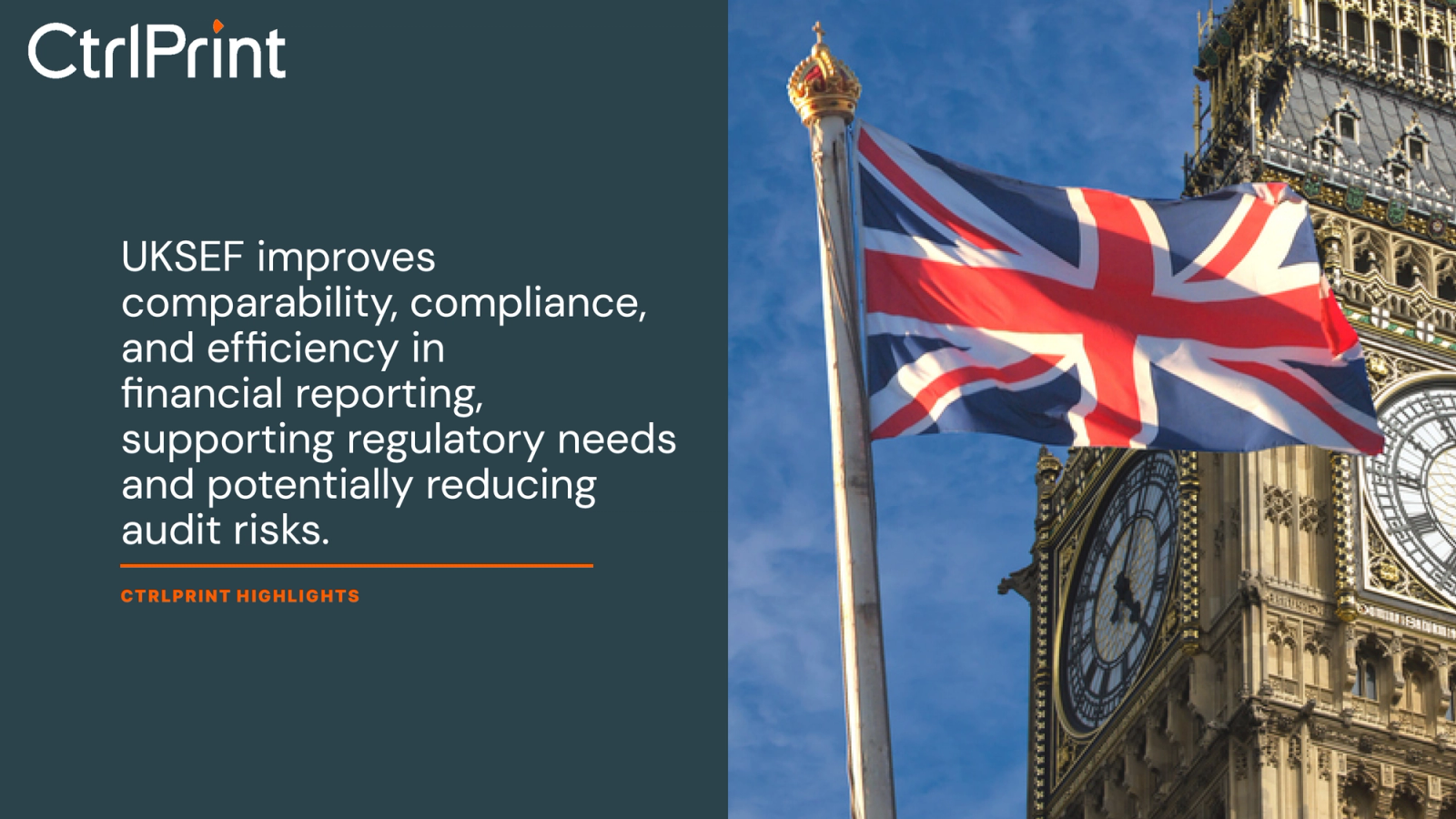In this article, we will cover everything listed companies in the UK need to know about UKSEF, including who is required to follow this format, the differences between UKSEF and ESEF, and how to make a seamless transition to this reporting format.
Before we begin, if you are in need of a corporate reporting software for your UKSEF submission, check how CtrlPrint can help you deliver compliant and captivating reports.
What is UKSEF?
UK Single Electronic Format, known as UKSEF, is an electronic reporting format that listed companies can use to file annual reports in the UK. UKSEF was created as a combination of the ESEF and IFRS taxonomies, to help the UK’s Financial Conduct Authority (FCA) maintain reporting and compliance. It includes UK-specific tagging information, which is legally required by Companies House.
Following the passage of the Streamlined Energy and Carbon Reporting (SECR) requirement and the Economic Crime and Corporate Transparency Bill, listed companies are now required to submit certain disclosures with their financial statements. UKSEF is used to tag specific financial information using the inline XBRL format and is overseen by the Financial Reporting Council (FRC).
How does UKSEF work?
Traditionally, companies issued their annual financial statements and disclosures in PDF format for on-screen reading. However, this limited insights, compliance checks, and comparability by regulators. UKSEF aims to overcome these challenges by using XBRL. Inline XBRL is a format that merges machine-readable data with a more standard HTML format.
This format provides data and information that is appealing and easy to understand, but has all of the backend requirements to leverage machine learning features, like automatic calculations and checks. By requiring companies to use XBRL, the FCA and Companies House can ensure that efficiency and accuracy are now even more in the spotlight.

What is the difference between UKSEF and ESEF?
UKSEF and ESEF share similar reporting principles. European Single Electronic Format, known as ESEF, mandates how annual financial reports are submitted in the EU. The UK adopted the provisions of the ESEF in January 2020, prior to the country’s withdrawal from the EU. Following the exit from the EU, the UK created UKSEF, leveraging many of the same tagging aspects as ESEF.
Starting in 2021, UK-listed companies had to comply with ESEF requirements. UKSEF expands on the tagging requirements set forth in ESEF, specifically related to SECR. However, listed companies have the choice to use either ESEF or UKSEF when issuing annual reports.
Who needs to file UKSEF?
Companies with transferable securities listed on UK-regulated markets must comply with either UKSEF or ESEF to file annual reports with the FCA. As mentioned, UKSEF has tagging features for UK-specific disclosures, making it beneficial for companies with mandatory reporting requirements under the SECR.
Additionally, since January 1, 2024, the FRC created a draft Conformance Suite for the UKSEF taxonomy, giving businesses the ability to use one format to file reports with multiple agencies. Although filing UKSEF is still optional for companies using ESEF, making the transition to leverage an all-in-one format might be beneficial.
The Role of UKSEF in Taxonomy
UKSEF plays a major role in taxonomy. For one, it creates a standardised classification system, helping companies produce uniform reports for simple comparability and analysis. This expedites the review process and makes it easier to detect mistakes and fraud.
Even though the primary difference between UKSEF and ESEF relates to SECR, the rise in ESG reporting requirements in the UK is bound to generate more reporting discrepancies. The FCA and the FRC have been working toward finalising the Conformance Suite and implementing more tagging options related to upcoming legislative changes.

How does UKSEF impact listed companies?
Whereas UKSEF is still in its infancy, ESEF has had a profound impact on listed companies, overhauling the way financial information is presented to regulators. UKSEF is looking to have the same impact, after details surrounding tagging requirements and upcoming legislative changes are finalised.
As more UK-specific tagging requirements are added to UKSEF, listed companies on UK markets may be required to adopt the reporting requirements. Similarly, certain third parties, such as lenders and investors, may require the UKSEF format for comparability and compliance, even if you have the choice between ESEF and UKSEF.
Regardless of your current reporting method, the UK seems to be looking long-term for UKSEF provisions, meaning your UK-listed company will need to closely monitor upcoming changes to maximise compliance.
How easy is the move from ESEF to UKSEF?
Making the move from ESEF to UKSEF is relatively straightforward. Listed companies in the UK or EU have already adopted an XBRL financial statement format under ESEF. As the UK begins to generate specific disclosure requirements related to ESG, UKSEF will become more prominent. UK-listed companies that are currently following ESEF may decide to transition over to UKSEF.
For one, this gives you access to a potentially streamlined reporting process under the draft Conformance Suite. In addition, you may reduce your audit risk when the FCA is able to easily identify required disclosures and evaluate financial information. If you have decided it is time to make the move, there are some logistics to keep in mind.
First, you need to be aware of the tagging differences. Despite UKSEF being built based on ESEF, it does have slightly different tagging requirements, especially regarding the SECR taxonomy. Next, understand the extension elements. Company-specific information that doesn’t have a tag outlined under UKSEF, is added as an extension element, which is then anchored to UKSEF elements with the closest meaning.
How to get started with UKSEF
Are you making the transition to UKSEF? How about issuing financial statements for the first time as a UK-listed company? Regardless of your reason for implementing UKSEF, it is important to have the right tools on your side.

